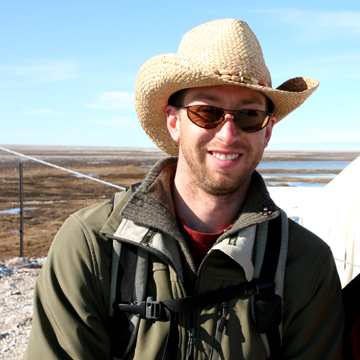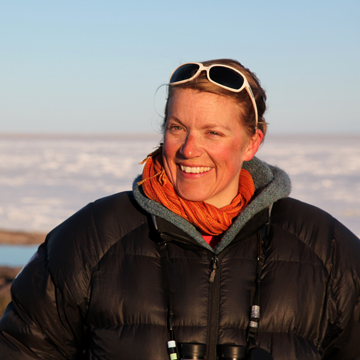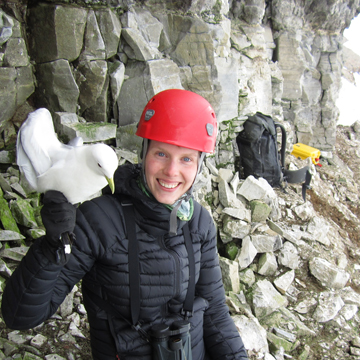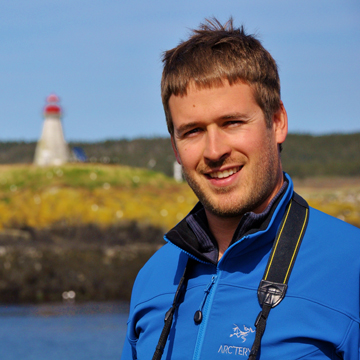Graduate Students
-
Darryl Edwards
PhD Candidate, Laurentian University. NSERC, CGS

Darryl studies the meaning behind bright plumage colours, as well as how plumage colour, hormones and immune function differ between males and females. To do this, Darryl uses both Arctic field-based studies where he subsequently measures hormones and immunity in the lab, as well as phylogenetic approaches (desk work). Darryl teaches an advanced statistics course at Laurentian University. He is also an all-round naturalist, home renovator and the father of two. Darryl is co-supervised by Dr. Albrecht Schulte-Hostedde (Laurentian University).
Darryl’s broad interests occur at the interface between life history theory and sexual selection. In particular, Darryl is interested in how the expression of secondary sexual traits such as bright plumage impose costs on other important functions like immunity. One aspect of his research focuses on plumage colouration, hormones, and immune function in an Arctic shorebird with sex-role reversal. That is to say that females have ‘brighter’ plumage than males and compete for male mates, while males are the sole care providers to offspring; hence adult roles are opposite of typical species. Uniquely, this system permits us to separate ‘maleness’, including high levels of testosterone, from the expression of secondary sexual traits; testosterone is thought to supply an important link between the expression of secondary sexual traits (like bright plumage) and immune function. In this regard, Darryl is investigating how hormones regulate sex-differences in immunity and the expression of plumage colouration, particularly in the sex-role reversed Red Phalarope.
RECENT MANUSCRIPTS
Edwards, D.B., M. Haring, A.I. Schulte-Hostedde and H.G. Gilchrist. 2014. Do social mating systems limit maternal immune investment in shorebirds? Canadian Journal of Zoology 92: 223-228.
Edwards, D.B. 2012. Immune investment is explained by sexual selection and pace-of-life, but not longevity in parrots (Psittaciformes). PLoS ONE 7: e53066. DOI: 10.1371/journal.pone.0053066.
Sam Iverson
PhD Candidate, Carleton University. NSERC, Weston Fellow, Molson Foundation Award

Sam’s thesis examines the demographic and population dynamic response of common eiders in the Canadian Arctic to emerging conservation challenges, including harvest, disease, and altered predator-prey relationships. His research explores whether life history characteristics evolved by Artic wildlife in past environments remain adaptive in the face of rapid anthropogenic change. Sam has led field projects from Africa to Central Asia. A key component of his work with the Gilchrist lab has been engaging with Inuit partners in Nunavut and Nunavik to address shared research aims. Sam is co-supervised by Dr. Mark Forbes (Carleton University).
Arctic wildlife species face an unpredictable environment characterized by high inter-annual variability in abiotic conditions. A common adaption in such situations is the evolution of traits that favor longevity over annual reproduction. This is a form of demographic buffering which allows individuals to endure periods when conditions are unfavorable and live to breed another day. However, species with a high degree of reliance on longevity may be particularly vulnerable to novel perturbations if evolution cannot keep pace with environmental change. Given these circumstances, key question become: Which perturbations should we be most concerned? Will demographic buffering effectively dampen the effects of environmental variation? Will species be pushed beyond the circumstances for which they are best suited?
Common eiders in the eastern Canadian Arctic are facing an array of challenges. They are an important subsistence resource for northern hunters, their eggs are an attractive prey item for predators, particularly polar bears during years when spring sea ice break-up occurs early and bears have reduced access to seals, and mass mortality events have been associated with the recent appearance of avian cholera in their population. Sam’s dissertation combines information gathered in surveys of common eider colonies distributed throughout Hudson Strait with data from a marked population at East Bay Island, Nunavut to assess interacting effects of climate, altered predation risk, and disease on eider nesting success, survival, and population dynamics.
RECENT MANUSCRIPTS
Iverson SA, Gilchrist HG, Smith PA, Gaston AJ, Forbes MR. 2014 Longer ice-free seasons increase the risk of nest depredation by polar bears for colonial breeding birds in the Canadian Arctic. Proc. R. Soc. B 281: 20133128. http://dx.doi.org/10.1098/rspb.2013.3128
Jennifer Provencher
PhD Candidate, Carleton University. Weston Fellow, NSERC, Bonneycastle Ducks Unlimited Fellow, Ontario Graduate Scholar
 Jennifer is examining how internal parasites and mercury may interact to affect reproductive decisions among birds; particularly during times of energetic stress (e.g. migration and breeding). She is conducting her Arctic field work with Inuit hunters in northern communities and also at the East Bay Island eider duck colony. In addition, several of her laboratory studies are ongoing at the National Wildlife Research Centre in Ottawa (Environment Canada). Jenn brings a range of skills and experience to the lab having first joined the group as a MSc student during the International Polar Year project, “Seabirds help detect Arctic ecosystem change”. Jenn also leads the annual Marine Bird Dissection Workshop each year in collaboration with the Nunavut Arctic College and the Nasivvik Centre. Jenn is co-supervised by Dr. Mark Forbes (Carleton University).
Jennifer is examining how internal parasites and mercury may interact to affect reproductive decisions among birds; particularly during times of energetic stress (e.g. migration and breeding). She is conducting her Arctic field work with Inuit hunters in northern communities and also at the East Bay Island eider duck colony. In addition, several of her laboratory studies are ongoing at the National Wildlife Research Centre in Ottawa (Environment Canada). Jenn brings a range of skills and experience to the lab having first joined the group as a MSc student during the International Polar Year project, “Seabirds help detect Arctic ecosystem change”. Jenn also leads the annual Marine Bird Dissection Workshop each year in collaboration with the Nunavut Arctic College and the Nasivvik Centre. Jenn is co-supervised by Dr. Mark Forbes (Carleton University).Many sea ducks are currently experiencing changing environmental conditions at northern latitudes that may affect their reproduction, condition and survival. As one example, rising temperatures in polar environments are known to have increased the release of mercury stored in glaciers and permafrost. Growing global industrialization has also generated higher atmospheric mercury emissions and subsequent mercury deposition in polar environments. These trends are concerning as mercury is a known neurotoxin that can negatively affect both body condition and reproductive success of sea ducks and other wildlife. Recently, rising temperatures in polar environments have also been predicted to alter rates of parasitism in wildlife as new and endemic parasite species may shift survival and/or host availability as warming temperatures alter food webs. Jenn is currently exploring how factors such as mercury and parasite burdens may interact to affect northern common eiders while breeding (Somateria mollissima). Her research includes both Arctic Field work as well as laboratory components. Collectively, Jenn’s preliminary findings suggest that both parasite and mercury burdens influence breeding decisions at arrival among female eiders in Arctic Canada, particularly among those arriving late and in poor body condition. You can learn more about Jenn’s work on her website: jenniferprovencher.com.
RECENT MANUSCRIPTS
Provencher, J.F., Mallory, M.L., Braune, B.M., Forbes, M.R., Gilchrist, H.G. 2014. Mercury and marine birds in Arctic Canada: effects, current trends and why we should be paying closer attention. Environmental Reviews, 22: 1–12.
Provencher, J.F., Braune, B., Forbes, M.R., Gilchrist, G., Mallory, M.L. 2014. Trace elements and gastro-intestinal parasites in high Arctic Arctic terns. Science of the Total Environment 476-477, 308-316.
Nora Spencer
MSc Student, Acadia University. Molson Foundation Award

Nora is examining the inter-annual distribution of the Endangered ivory gull in the Canadian Artic using satellite telemetry tracking data. Working at the computer lab at Acadia University (Geographic Information Systems), Nora’s study will help map the critical winter habitat of this rare species in the North Atlantic. Nora completed her BSc at Dalhousie University, with a special interest in exploring animal movements in relation to their conservation. Nora has a red belt in kickboxing and enjoys backpacking. She is co-supervised by Dr. Mark Mallory (Acadia University).
The Arctic is a rapidly warming environment due to climate change. Seabirds can be used as indicators of ecosystem health to track how climate change is affecting arctic species. Not only are they easily seen and tracked, but they are also sensitive to changes in the environment. For example, food availability is dictated by the timing of sea ice recession in the spring, an environmental cue for migratory seabirds to travel north to breed. However, early or late recession of sea ice may alter this timing for seabirds that depend on ice for foraging and breeding, such as the ivory gull (Pagophila eburnea). The ivory gull is an endangered seabird that has experienced a decline of > 70% in population since the 1980s. Very little is known about the ivory gull; however, a dataset of daily location records sent from satellite transmitters attached to gulls between 2010 and 2013 were available to describe migratory patterns and behaviour of the ivory gull. Nora’s work involves using a mapping computer program (ESRI’s ArcGIS). Nora’s recent findings suggest that ivory gull migratory movement and wintering locations are strongly dictated by the formation and recession of the sea ice each year.
RECENT MANUSCRIPTS
Travis White
PhD Student Carleton University. NSERC IPS-2, WWF

Travis’ interests in the natural world are noticeably diverse. Having completed a M.Sc on the overwintering ecology of wood turtles, in addition to a technologist diploma in Ecosystem Management, Travis brings a broad range of technical and analytical skills to the Gilchrist Lab. His ongoing PhD research is examining spatio-temporal patterns in marine bird use of the Canadian Arctic. The greatest part of his time is spent analyzing tracking data using RStudio and ArcGIS softwares at the Landscape Science Laboratory of the National Wildlife Research Center. He awaits his upcoming field work where he will be deploying GPS devices on thick-billed murre (Uria lomvia) at Digges Island, Nunavut, to examine sub colony partitioning and environmental factors affecting foraging behavior. Travis is co-supervised by Dr. Mark Mallory (Acadia University) and Dr. Lenore Fahrig (Carleton University).
Numerous marine spatial planning initiatives are underway to protect wildlife resources while allowing sustainable development in the Canadian Arctic. Yet, credible scientific data to identify key marine habitats are limited for most species, including marine birds. To help address this deficiency, Travis will use available tracking data from 13 species to examine multi-species use of different habitats. The outputs of his spatial analyses will allow the delineation of key marine bird hotspots for both Environment Canada and WWF conservation efforts of Arctic wildlife. Additionally, he (and the Gilchrist Team) will deploy GPS devices to investigate foraging behavior and identify key marine sites around important thick-billed murre colonies. These finer-scale data will help inform industrial activity of regions of high and low potential environmental impact.
RECENT MANUSCRIPTS
FORMER STUDENTS AND POST DOCTORAL RESEARCH ASSOCIATES
- Dominique Henri. Integrating Local Ecological Knowledge into wildlife management: case studies of migratory birds in Nunavut Canada. Doctorate . Oxford University. (Rhodes Scholarship). 2007-2011.
- Dr. Joel Heath. “ Factors affecting the foraging energetics and habitat use of common eider ducks wintering in Arctic Canada”. Post Doctoral Research Associate with the Math Department, University of British Columbia. (NSERC). 2008-2011.
- Dr. Sebastien Descamps. “ Effects of harvest and avian disease on the population demography of common eider ducks”. Post Doctoral Research Associate. Biology Department, Carleton University. (NSERC). 2007-2009.
- Dr. Oliver Love. Stress hormones: a link between maternal condition and sex-biased reproductive investment: a case study of the Common Eider. Post Doctoral Research Associate. Biology Department, University of Quebec at Rimouski. (NSERC). 2007- 2009.
- Edith Senechal. “Interactions between timing of breeding, egg production, and post-laying energetic needs in a capital breeder: the arctic-nesting Common Eider. Masters of Science, University of Quebec at Rimouski. Co-supervised by Dr. Joel Bety (FCAR). 2006-2008.
- Lisha Berzins. “Trade offs between innate immunity and incubation demands during breeding among Black Guillemots nesting in the Canadian Arctic. Masters of Science, Trent University. Co-supervised by Dr. Gary Burness. (OGS). 2006-2008.
- Isabel Buttler. “Effects of avian cholera on the reproductive ecology and colony dynamics of common eider ducks”. Masters of Science. Carleton University. Co-supervised by Dr. Mark Forbes. (NSERC). 2007-2008.
- Paul Smith. “Comparative ecology of shorebirds in the Canadian Arctic”. Doctorate. Carleton University. Co-supervised by Dr. Mark Forbes. (NSERC). 2000-2004.
- Dominique Henri. Local Ecological Knowledge of bird conservation in Nunavut Canada. Oxford University. (Rhodes Scholarship). 2006-2007.
- Peter Fast. “Factors affecting reproductive success among Northern Common eiders in Arctic Canada”. Masters of Science, University of Saskatchewan. Co-supervised by Dr. Bob Clark. (NSERC). 2002-2003.
- Joel Heath. “Foraging and diving energetics of Common Eider Ducks wintering in polynyas in Hudson Bay”. Doctorate. Simon Fraser University, Vancouver, British Colombia. Co-supervised by Dr. Ron Ydenberg. (NSERC). 2002-2007.
- Karel Allard. “Influence of foraging territoriality among Herring Gulls nesting within a Common Eider Duck colony”. Doctorate, University of New Brunswick. Co-supervised by Dr. A. Diamond. 2000-2004.
- Laura McKinnon. “Mate selection and paternity among Common Eider Ducks in the Canadian Arctic”. University of Michigan State. Co-supervised by Dr. Kim Scribner. 2002-2004.
- Kerrith McKay. “The influence of male colony attendance on nest success and paternity among Common Eider Ducks”. Masters of Science. Guelph University. Co-supervised by Dr. Tom Nudds. 2001-2003.
- Dr. Joël Bêty. “Timing of breeding and optimal resource allocation among Common Eider Ducks nesting in the Arctic”. Post Doctoral Research Associate. University of New Brunswick, Fredericton. (NSERC). 2001-2003.
- Paul Smith. “Predation, life history, and shorebird nest site choice”. Masters of Science. University of British Columbia. Co-supervised by Dr. James N. M. Smith. (NSERC). 2001-2003.
- Sarah Jamieson. “Endongenous reserve dynamics of Common Eider ducks during winter and migration”. Masters of Science, University of New Brunswick. Co-supervised by Dr. A. Diamond. (NSERC). 2000-2003.
- Iain Stenhouse. “Ecology of Sabine’s Gulls nesting on Southampton Island, Nunavut: the influence of nesting dispersion”. Doctorate, Memorial University. Co-supervised by Dr. W. Montevecchi. 1999-2003.
- Grace Bottitta. “Factors affecting incubation behavior and nest success of Common Eider Ducks in the Arctic”. Masters of Science, Trent University. Co-supervised by Dr. Erica Nol. (OGS) 1998-2000.
- Dr. Gregory Robertson. “Population demographics of the Hudson Bay Common Eider Duck following a catastrophic population decline”. Post Doctoral Research Associate. University of New Brunswick, Fredericton. 1998-1999.










